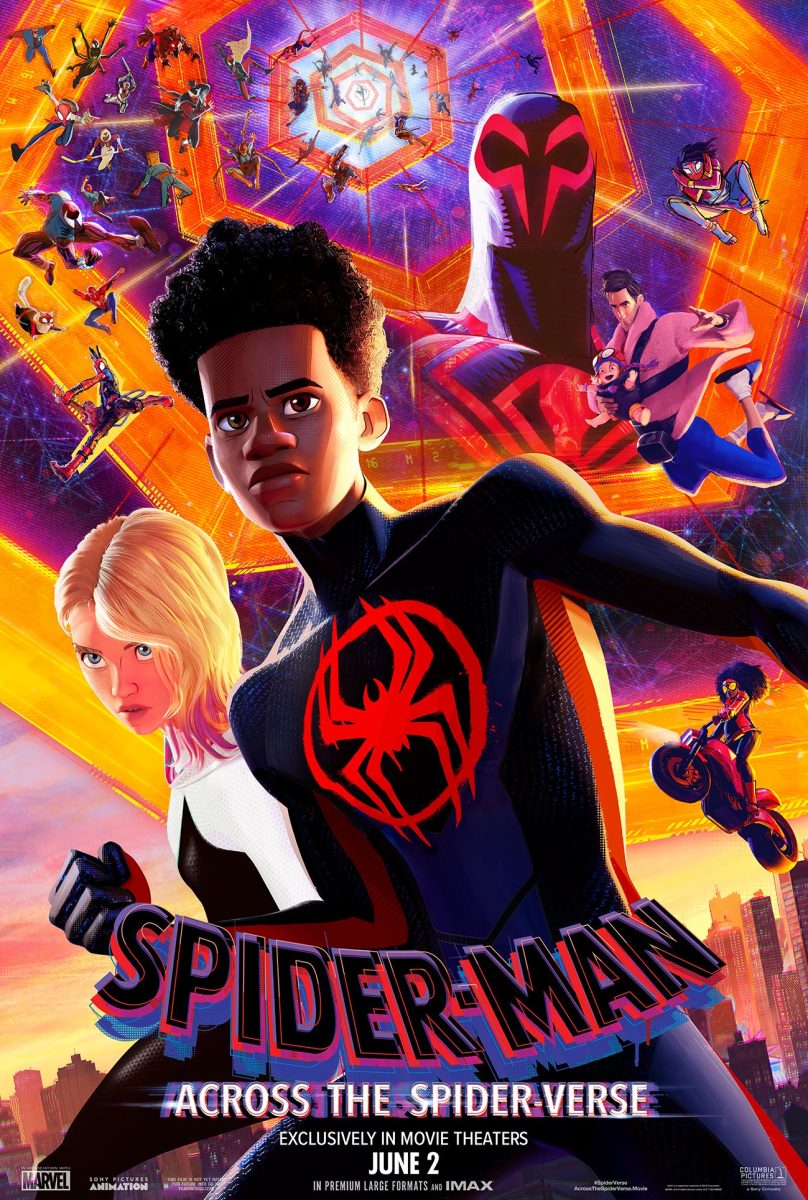In the sequel to the 2018 animated film “Spider-Man: Into the Spider-Verse,” animators of “Spider-Man: Across the Spider-Verse” once again excite audiences by inviting them into distinct universes with various alluring art styles, continuously leaving the audiences’ eyes wanting more. Nominated for Best Animated Feature, the film masterfully continues the host of emotions present in its predecessor and displays the charming natures of Miles Morales (voiced by Shameik Moore) and the Spider-People he encounters.
The story resumes over a year after the events of “Into the Spider-Verse,” opening in Gwen Stacy’s (Hailee Steinfeld) universe, allowing viewers to learn more about her backstory. Gwen, visibly struggling with the pressure of secretly being Spider-Woman, quarrels with her police captain dad about Spider-Woman’s true intentions. In the movie’s first fight scene, Spider-Woman takes on an Italian version of the villain Vulture from a Renaissance-esque universe. Once Vulture has the upper hand, a new Spider-Man, Miguel O’Hara or Spider-Man 2099 (Oscar Isaac), portals into the fight, accompanied by his iconic theme and partner Jessica Drew (Issa Rae). The trio band together to send the anomaly Vulture back to his universe. Spider-Woman, finished with her job, attempts to flee back home, but is caught by her father on the way out. Staring into the barrel of his gun, Gwen reveals her identity and is met with the response of a hard-set cop instead of her loving father. Faced with either being jailed or joining Spider-Man 2099 and Jessica to help control anomalies in the Spider-Verse, Gwen chooses to embark on a journey that forever changes the course of her and Miles’s lives.
With really only one other title contesting for the Oscar in the Animated Features category, “Across the Spider-Verse” stands a strong shot at winning due to the film’s enthralling visual experience masterfully accompanied by a powerful, relatable story.
The animators’ use of comic-book-inspired action sequences, on-screen stylized captions that accentuate each character’s personality and thoughts, and strategic colors to convey emotion keep viewers engaged throughout every scene. When Gwen first talks with her dad in her room, her dad is encased by a warm background while Gwen is shrouded with cold hues. Upon embracing her dad, warmth literally radiates in the air between and around them. A similar effect occurs at the end of the film when Gwen reunites with her dad and he wraps her in his arms, causing dark blue hues to transcend into lighter, brighter ones.
Even though hiding spider powers is uncommon amongst teens today, the film captures the more general qualms of being a teenager and the battle to open up to your parents. This is shown when Miles’s mom insinuates that he may have a tough time feeling that he belongs in higher educational spaces due to his racial identity; it’s cleverly tied into the ostracization Miles begins to feel from the other Spider-People.
Accentuating the relatability of the film, the dialogue in “Across the Spider-Verse” is one of the most entertaining parts. The conversations between Miles’s parents can easily make you forget the fact that the movie was meticulously crafted frame-by-frame. While the comedy invites some well-deserved chuckles during its runtime, the jokes can get a bit gimmicky when including mainstream themes. Pavitr Prabhakar, aka Mumbattan Spider-Man, complains one too many times about Westerners ignorantly saying “chai tea” or “naan bread.” In a similar vein, the reappearance of Peter Parker quickly turns from a heartfelt moment with Miles into an insufferable piece of comedic relief with Peter’s incessant “daughter-loving dad” personality. And yes, the Spider-Man pointing meme is well overdone.
An issue present in many blockbuster action movies—specifically superhero movies—is the pacing. “Across the Spider-Verse” takes about an hour out of its 140-minute runtime for Miles to start re-exploring the Spider-Verse. Thus, the movie builds up a solid but not boring foundation that supplements the plot’s later conflicts and avoids rushing key moments to fit all the interesting action into the last 20 minutes. However, the driver of the plot is a cliché of many superhero movies. The supervillain Spot’s (Jason Schwartzman) treachery against Miles is because his life was forever ruined by Miles trying to save the world. While Spot is a lively character, his sudden bursts of anger don’t mesh well with his humorous personality, causing his well-deserved animosity towards Miles to come off as a sensitive middle-aged man who has a concerning obsession with a 15-year-old boy who hurt his ego.
Nonetheless, “Spider-Man: Across the Spider-Verse” will be a tough film to beat among less popular titles. Much of its acclaim and strong standing holds up to and arguably surpasses the quality of the trilogy’s first film. Hopefully, this is the universe where this film wins.













